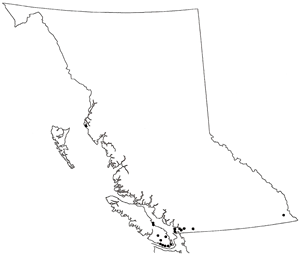This is an introduced European species of earthworm. Reynolds (1977) provides the following description for it: “Length 65-180 mm, diameter 7-8 mm, segment number 140-158, prostomium epilobic, first dorsal pore 11/12 or 12/13. Clitellum xxix-xxxiv. Tubercula pubertatis xxx-xxxiii. Setae closely paired anteriorly, CD<AB<BC<AA<DD, and widely paired posteriorly, AB>BC>CD. Setae of x, xviii, xix, xx, xxi frequently on white genital tumescences. Males pores on xv with well-defined narrow papillae. Seminal vesicles, four pairs in 9-12, with the pairs in 11 and 12 larger than the pairs in 9 and 10. Spermathecae, two pairs opening between c and d in 9/10 and 10/11. Body cylindrical but octagonal posteriorly. Colour, blue-grey or whitish.”
Source: Reynolds, John W. 1977. The Earthworms (Lumbricidae and Sparganophilidae) of Ontario. Life Science Miscellaneous Publications, Royal Ontario Musuem, Toronto, with permission.
Octolasion cyaneum (Savigny, 1826)
Earthworm; Woodland Blue Worm
Family: Lumbricidae
Earthworm; Woodland Blue Worm
Family: Lumbricidae
Map

Distribution of Octolasion cyaneum in British Columbia.
(Click on the map to view a larger version.)
Source: Marshall and Fender (2007)
Introduction
|
Illustration
Click on the image(s) below to view an expanded illustration for this taxon.

Illustration Source: Reynolds, John W. 1977. The Earthworms (Lumbricidae and Sparganophilidae) of Ontario. Life Science Miscellaneous Publications, Royal Ontario Museum, Toronto.
Species Information
Biology
|
Habitat
|
Distribution
|
Status Information
BC Ministry of Environment: BC Species and Ecosystems Explorer--the authoritative source for conservation information in British Columbia. |